Alloy steel plays a pivotal role in various industries, offering a wide array of options for applications that demand strength, durability, and versatility. One such remarkable alloy is 4340, renowned for its exceptional properties. In this post, we’ll delve into the world of Alloy Steel 4340, exploring its composition, applications, and why it stands out in the realm of materials engineering.
Understanding Alloy Steel 4340
Alloy Steel 4340 is a heat-treatable and low-alloy steel containing chromium, nickel, and molybdenum. Its composition imparts high strength, toughness, and wear resistance, making it a preferred choice for critical components in aerospace, automotive, and industrial machinery.
Composition of Alloy Steel 4340
To comprehend the prowess of Alloy Steel 4340, let’s break down its composition:
| Element | Percentage |
|---|---|
| Carbon | 0.38-0.43% |
| Manganese | 0.60-0.80% |
| Phosphorus | 0.035% max |
| Sulfur | 0.040% max |
| Silicon | 0.15-0.30% |
| Chromium | 0.70-0.90% |
| Nickel | 1.65-2.00% |
| Molybdenum | 0.20-0.30% |
Applications Across Industries
The versatility of Alloy Steel 4340 is evident in its widespread applications:
- Aerospace Components: Alloy Steel 4340 is a preferred choice for critical aerospace components such as landing gear, shafts, and other structural parts due to its high strength-to-weight ratio.
- Automotive Engineering: In the automotive sector, this alloy finds application in gears, crankshafts, and other high-stress components, enhancing overall performance and durability.
- Industrial Machinery: 4340 plays a crucial role in manufacturing machinery subjected to heavy loads, ensuring reliability and longevity.
Advantages of Alloy Steel 4340
When it comes to choosing materials for demanding applications, 4340 stands out for several reasons:
- High Strength: The alloy’s inherent strength makes it suitable for applications where durability and resilience are paramount.
- Toughness: Steel 4340 exhibits excellent toughness, especially after heat treatment, making it ideal for components in high-stress environments.
- Machinability: The alloy’s machinability is noteworthy, allowing for intricate designs and precision in manufacturing processes.
Addressing Common Questions
Q1: Can Alloy Steel 4340 be welded?
Yes, 4340 is weldable. However, it’s essential to follow proper welding procedures to maintain the alloy’s mechanical properties.
Q2: What is the significance of the alloy’s nickel content?
The nickel content contributes to the alloy’s toughness, impact resistance, and hardenability.
Q3: Are there alternatives to 4340?
While there are alternatives, Steel 4340’s unique combination of properties makes it a preferred choice for many critical applications.
Q4: How does heat treatment impact Alloy Steel 4340?
Heat treatment enhances the alloy’s hardness, strength, and resistance to wear, providing tailored properties for specific applications.
Q5: Can Steel 4340 be used in corrosive environments?
While the alloy offers good corrosion resistance, it may not be suitable for prolonged exposure to highly corrosive environments. Consider protective coatings for such applications.
In conclusion, Alloy Steel 4340 stands as a testament to the advancements in materials engineering, offering a blend of strength, toughness, and versatility. Whether soaring through the skies in aerospace applications or enduring the rigors of automotive and industrial realms, Steel 4340 is a reliable choice, meeting the demands of modern engineering challenges.
For further inquiries about Alloy Steel 4340 or other specialized steel materials, feel free to reach out to us at sharon@otaisteel.com or via WhatsApp at +8613580960968. We’re here to provide solutions to your material challenges.











